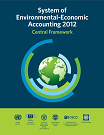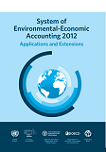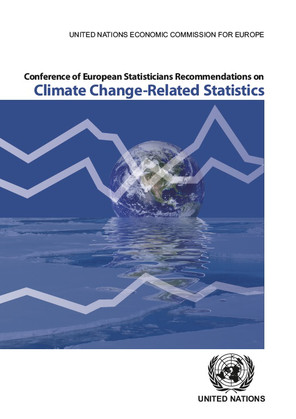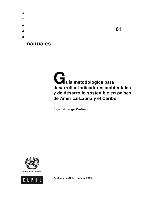Environment and climate change statistics for Latin America and the Caribbean
Environment Statistics - FDES Components
According to Manual 61 of ECLAC, Methodological guide to develop environmental and sustainable development indicators in Latin American and Caribbean countries (MDEA/FDES), environmental statistics are statistical series produced regarding the main environmental variables and dynamics in the territory and time such as: water, air, climate, biota (biodiversity), land use, forests, coastlines, marine ecosystems, pollution (breathable air, seawater), solid waste, access to water and basic sanitation, extreme events and disasters, etc.
The FDES 2013 is a flexible, multipurpose conceptual and statistical framework that is comprehensive and integrative in nature. It marks out the scope of environment statistics and provides an organizing structure to guide their collection and compilation and to synthesize data from various subject areas and sources, covering the issues and aspects of the environment that are relevant for analysis, policy- and decision-making. The FDES organizes environmental statistics into six components, each of which is broken down into sub-components and in turn into statistical topics. The six components include: 1) Environmental conditions and quality; 2) Environmental resources and their use; 3) Residuals; 4) Extreme events and disasters; 5) Human settlements and environmental health; and 6) Environmental management and protection. Statistical topics represent the quantifiable aspects of the components and are grouped into sub-components, taking into account the types and sources of statistics needed to describe them.
Structure of FDES
Chapter 1 of the FDES 2013 provides an overview of the main characteristics of environment statistics. It identifies the main uses and user groups and the relationship between environmental data, statistics, accounts and indicators.Chapter 2 presents the conceptual foundation and scope of the FDES. It explains the underlying fundamental concepts and how they have been translated into the six components that constitute the Framework.Chapter 3 provides an expanded discussion of the components, subcomponents and statistical topics of the FDES. It describes the relevance of the statistical topics, the typical data sources and institutional partners. Chapter 4 presents the three-tiered organization of the Basic Set of Environment Statistics, based on the relevance, availability and methodological development of the statistics. Chapter 5 provides examples of the application of the FDES to selected cross-cutting environmental and socioeconomic issues (such as climate change), as well as to specific sectoral or thematic analytical needs (such as agriculture and the environment, water management, energy and environmental sectors).
-
 State of the Global Environment: Part A
by
Publication Date: 2019
State of the Global Environment: Part A
by
Publication Date: 2019 -
 Remaining Data and Knowledge Gaps: Part D
by
Publication Date: 2019
Remaining Data and Knowledge Gaps: Part D
by
Publication Date: 2019
-
 Perspectivas del Medio Ambiente Mundial 6
by
Publication Date: 2019
Perspectivas del Medio Ambiente Mundial 6
by
Publication Date: 2019 -
 Global Set of Climate Change Statistics and Indicators
by
Publication Date: 2022
Global Set of Climate Change Statistics and Indicators
by
Publication Date: 2022
-
 Outlooks and Pathways to a Healthy Planet with Healthy People : Part C
by
Publication Date: 2019
Outlooks and Pathways to a Healthy Planet with Healthy People : Part C
by
Publication Date: 2019 -
Measuring Progress Towards achieving the environmental dimension of the SDGs by
Publication Date: 2019
Documents and publications
-
Environment Statistics Self-Assessment Tool (ESSAT) by
Publication Date: 2017 -
Framework for the Development of Environment Statistics (FDES 2013) by
Publication Date: 2013 -
 System of Environmental-Economic Accounting 2012 - Central Framework
by
Publication Date: 2012ST/ESA/STAT/Ser.F/109
System of Environmental-Economic Accounting 2012 - Central Framework
by
Publication Date: 2012ST/ESA/STAT/Ser.F/109 -
System of Environmental-Economic Accounting - Ecosystem Accounting by
Publication Date: 2021 -
 SEEA Applications and Extensions
Publication Date: 2014
SEEA Applications and Extensions
Publication Date: 2014 -
Glossary of Environment Statistics by
Publication Date: 2016 -
 Environment at a Glance
by
Ultima edición: 2020
Environment at a Glance
by
Ultima edición: 2020 -
 Environment at a Glance Indicators
by
Publication Date: 2022
Environment at a Glance Indicators
by
Publication Date: 2022
Databases
-
ECOLEX- The gateway to environmental law | Legislación relativa a la diversidad biológica Este enlace se abre en una nueva ventanaECOLEX is an information service on environmental law, operated jointly by FAO, IUCN and UNEP.
-
Eurostat - Environmental statistics and accounts Este enlace se abre en una nueva ventanaEstadísticas ambientales que capturan el estado del medio ambiente y las presiones sobre él, así como el impacto de las actividades humanas y las medidas adoptadas para mitigar ese impacto. Los temas incluidos son: emisiones al aire; desperdiciar; agua; biodiversidad; y sustancias peligrosas.
-
FAOSTAT Este enlace se abre en una nueva ventanaCurrenlty, online multilingual database containing more than 1 million time series from over 210 countries and territories covering agriculture, nutrition, fisheries, forestry, food aid, land use and population statistics. See more FAO statistical resources
-
OECD.Stat Este enlace se abre en una nueva ventanaOECD.Stat includes data and metadata for OECD countries and selected non-member economies.
OECD.Stat incluye datos y metadatos para países de la OCDE y economías no miembros seleccionadas. -
UNSD Environmental Indicators Este enlace se abre en una nueva ventanaUNSD disseminates global environmental statistics with indicators compiled from a wide range of data sources, on ten themes: Air and climate; biodiversity; energy and minerals; forests; governance; inland water resources; land and agriculture; marine and coastal areas; natural disasters; and waste.
Metodologías y clasificaciones
-
Central Product Classification (CPC) /
Fecha de publicación: 2015 -
The Standard Industrial Classification of All Economic Activities (ISIC), Rev.4 /
Fecha de publicación: 2008 -
Indicators of sustainable development: guidelines and methodologies, Third Edition /
Fecha de publicación: 2007 -
 Recommendations on Climate Change-Related Statistics
/
Fecha de publicación: 2014
Recommendations on Climate Change-Related Statistics
/
Fecha de publicación: 2014 -
 Concepts and Methods of Environment Statistics: Statistics of the Natural Environment
/
Fecha de publicación: 1991
Concepts and Methods of Environment Statistics: Statistics of the Natural Environment
/
Fecha de publicación: 1991
-
Herramientas conexas del Marco para el Desarrollo de Estadísticas Ambientales (MDEA)Rayén Quiroga - División de Estadísticas, Estadísticas Ambientales - Comisión Económica para América Latina y el Caribe (CEPAL)
-
Indicadores ambientales ODS
Listado de indicadores relevantes para el monitoreo del pilar ambiental de los Objetivos de Desarrollo Sostenible (ODS).



